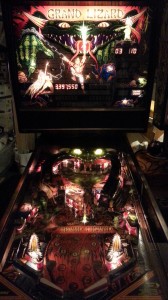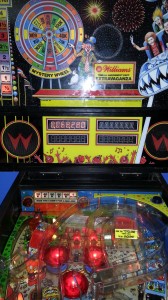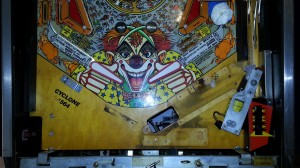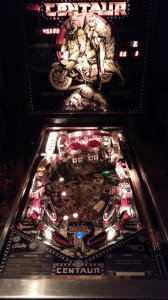What’s the value of a Dead Machine?
Certain pinball parts are scarce and are not reproduced, and therefore retain a lot of value even when in “very used” condition. Other parts are periodically reproduced, and are expensive as well. Some parts work for a range of machines of an era, while other parts are specific to a given game. This means that you must reach owners of a specific game era, or game in order to sell the part. Best places to do this is on Pinside.com (http://pinside.com) and Mr. Pinball Classified (http://user.xmission.com/~daina/wanted_and_for_sale.html)
The following parts are easy to ship, and should never be junked:
(lockdown bar assembly, transformer, display, drop target assemblies, stationary targets) — these can work for a range of machines.
Other parts are game-specific, and you’ll need other owners of the exact same machine to have interest in the parts: (backglass, ramps, spinners, and any game-specific toys or motors, and the playfield itself (assuming it’s in fair or better condition.)
Items that you would rather buy new than re-use are most of the smaller <$20 components under the playfield: (solenoids, flippers, flipper assembly brackets, wire, worn switches, etc.)
The cabinet has value, only it’s not cost-effective to ship the body. You might sell it for $150, but it’s going to cost someone $450 to ship it across the country. Try for a local sale on a cabinet.
This means that most of the parts in a pinball machine have value. What does this mean for the seller? This means any bucket of bolts that doesn’t turn on still has a lot of value. Don’t let anyone take a poor condition machine or one that won’t start up off your hands for under $500 (in 2013.)
As a buyer, what does this mean? It means if you can negotiate a price under $500, you simply can’t lose on buying a pin. If someone is trying to sell you a pin that “worked fine yesterday, then stopped working,” and you are worried about the risk, just try to get under the magical $500 mark, and eliminate your risk, in case you need to get out of the machine in a few months, if you are unable to repair it within your budget.
How much should I negotiate prices based on condition flaws?
When you go to review a machine you want to buy, make sure you take a good look at all aspects of the machine’s quality and be willing to negotiate the price down based on how easy/pricey/possible it is to replace the item. In some unlucky cases, there are NO reproduction items available (Taxi Spinout Ramp) and so if that doesn’t work you are looking at some crazy ebay auction of $300+ to try and snag a ramp that works. Be sure to know what CAN be replaced and what CANNOT be easily replaced BEFORE you go to look at a pin. Do research and prepare to discuss and negotiate the following items:
Assume that you find a pinball machine that you really want, and you decide what price you want to pay for it in “X condition.” For me, I’ll use “Taxi” as an example in 2013 in California. I would want one in good condition, with a very-good condition playfield. I would price it at $1400. The only things I’d pay a little more for, would be LEDs. They take forever to install, and they are not free. Now based on what isn’t matching my standards for a good condition Taxi, I’d negotiate down the price accordingly. (all prices below are rough estimates for 2013).
1) Worn backglass (-$250)
If the backglass is worn, and doesn’t meet your standards, you must drop the price for this. Check and see if there are reproductions available, and what the cost is for them. There are many places to find them. Search the web for “pinball backglass reproduction” (without the quotes), and you should find 5+ companies that make them. For Taxi, I cannot find one, so I would put the value at $250, and dock some or all of that if I feel that that part must be replaced soon.
2) Worn playfield (-$600)
If the playfield requires some work, you’ll need to dock for that as well. This is subjective based on how much you value your time, and whether you think you can do the touch up work or not.
3) Broken Plastics (-$125)
Just like with the backglass, it comes to availability of parts. You can find them used on Mr. Pinball, and new on 5+ sources online. Search for “pinball plastic sets” and you’ll see who can help you. If there are no plastic reproductions available, then you are relying on used parts to save you later on. That would be a deal-breaker for me.
4) Body Damage (-$150, if it’s really faded and needs replacement)
It costs about $150 for stencils to help you re-paint a body that needs it. Assuming your time is free, and the stencils are available, and you or a friend has the right location and supplies to repaint a machine, you would price a poor body at $150 and up. I tend to not ding much for bodies, since I buy player machines, and expect a little bruising on them.
5) Poor Displays (-$200)
Run diagnostic tests on all 4 displays, make sure all cells work properly. Also, leave the machine on for 1 hour+ and let it get hot in there, and see if there is any change to the old plasma displays. If it has newer LED displays from vendors such as Rottendog or Pinscore, then that’s a nice cost-saving benefit for you, but it’s not something you should be paying for. If it’s color, or has some perk over the old-school orange color, that’s up to you if you want to pay for that.
6) LEDs (+0 to +$150)
LEDs are not cheap. The LEDs for the playfield are roughly $100-$125 in 2013, depending on quality and style choices. For the backbox it’s roughly $50. If someone says their game has LEDs, take a close look and see how many are in there. LEDs are not free, and you might want to pay a little extra for a pin with them, or charge a hair more if you are selling one with them in there.
7) New Rubbers (+$20)
New rubber kits cost ~$20, and it takes 10-15 hours to tear down a playfield and replace all the rubbers and build it back up. If you cut corners, and clean NOTHING, then surely you could do it in less time. When I do a full tear down, I make sure to do other things such as polish, wax, clean, and adjust other things while all the parts are off the playfield. It’s up to you whether you want to charge for your time or not, or pay for another’s time or not. The rubbers alone are nearly free in the scheme of things, but take a LONG time to install depending on the complexity of the game’s plastics/ramps/toys on top.
8) Broken Ramps / Toys (-$100 per item if it’s available, $300 if not)
If the machine you are looking at has broken ramps or toys, then take another look online for reproductions. Search for “pinball reproduction ramps” and include the name of the machine you are looking for. You will get at least 5+ vendors trying to sell you the part. On average, ramps are $100 in 2013. If you are looking at a cracked ramp, then dock the price to cover the part. If you are selling a machine with a broken ramp, be sure to disclose that early on.
9) Weak flippers, weak sling shots, weak pop bumpers ($0)
All of these are easily adjustable, and upgraded with <$20 parts. Don’t hassle people over these small things. Sell a machine that is well tuned and plays well, and if you are buying from someone whose machine has soft flippers, just ignore it, and focus on things that will truly cost you big $$$ to get up to good condition.
So let’s take a worst-case example. Last December, I was looking at a fair condition Taxi with 10+ issues on it. I wanted my first “beater” that I could restore back to good condition. But just like buying a “it used to work” automobile, I didn’t want to sink much $$$ into it.
The following needed to be replaced or restored:
body (-$600) – had bad artwork, so I was looking at getting a CPR playfield and starting from scratch.
cabinet (-$150) – had red paint all over it. Some child went nuts on it.
backglass was “ok” and I had to dock a little for that in my head. (-$50)
But the game worked. He was asking $1500 and I offered $500. Why is that? Because I saw $800+ in work to get it up to what I saw as a $1400 value maximum, (assuming it was in good to very-good condition when I’m done restoring it.) And I wanted to cover a little of my time as well in making the thing play well again. It was in sorry shape just coming off the route. Even though a Taxi is a little hard to find, I proudly walked away from it.
Months later, I got VERY lucky and found a Lola Taxi in very good condition (all around) for <$1500, and the rest is history.
Moral to the story?
Wait for it…




